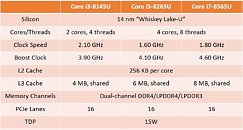Thursday, August 9th 2018

Intel "Whiskey Lake-U" Core Processor Lineup Detailed
Intel is giving final touches to its 9th generation Core "Whiskey Lake-U" processors for Ultrabooks and other ULV platforms. Successors to 8th Gen "Kaby Lake Refresh" chips, these 15-Watt SoCs may not pack a newer microarchitecture in terms of IPC increases, but Intel is building them on the latest iteration of its 14 nm node, along with tweaks made to their Turbo Boost algorithm, which combined with higher boost clocks, should offer better performance than the previous generation.
The lineup begins with the Core i3-8145U, successor to the i3-8130U. This 2-core/4-thread chip is has a lower nominal clock at 2.10 GHz (vs. 2.20 GHz of its predecessor), but significantly higher boost clocks of 3.90 GHz (vs. 3.40 GHz of the i3-8130U). The Core i5-8265U and top-end i7-8565U are both 4-core/8-thread chips with a nominal clocks of 1.60 GHz and 1.80 GHz, respectively. The i5-8265U has a boost clock of 4.10 GHz and 6 MB of L3 cache; while the i7-8565U tops that with 4.70 GHz boost clocks, and 8 MB of L3 cache. All three chips have 15W TDP, configurable to 25W by applying the "high performance" power scheme.
Source:
Anandtech
The lineup begins with the Core i3-8145U, successor to the i3-8130U. This 2-core/4-thread chip is has a lower nominal clock at 2.10 GHz (vs. 2.20 GHz of its predecessor), but significantly higher boost clocks of 3.90 GHz (vs. 3.40 GHz of the i3-8130U). The Core i5-8265U and top-end i7-8565U are both 4-core/8-thread chips with a nominal clocks of 1.60 GHz and 1.80 GHz, respectively. The i5-8265U has a boost clock of 4.10 GHz and 6 MB of L3 cache; while the i7-8565U tops that with 4.70 GHz boost clocks, and 8 MB of L3 cache. All three chips have 15W TDP, configurable to 25W by applying the "high performance" power scheme.

22 Comments on Intel "Whiskey Lake-U" Core Processor Lineup Detailed
browser.geekbench.com/v4/cpu/compare/9106992?baseline=9228031
GFXbench
I wouldn't be surprised if it'll surpass 50W when running full boost.
It's like people live in a fantasy world where laptop makers, or Intel, aren't looking to cut corners o_O